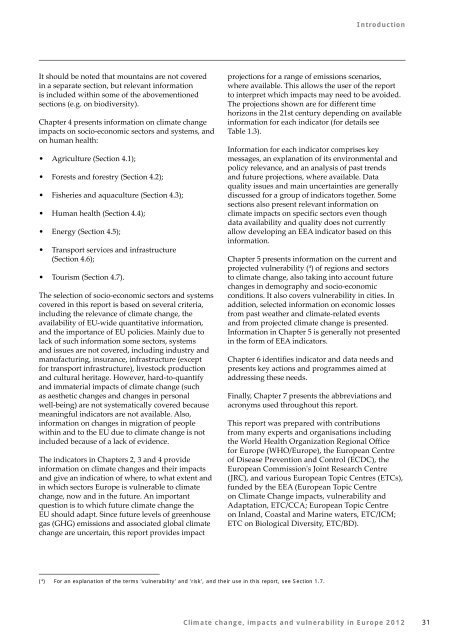Climate change, impacts and vulnerability in Europe ... - MemoFin.fr
Climate change, impacts and vulnerability in Europe ... - MemoFin.fr
Climate change, impacts and vulnerability in Europe ... - MemoFin.fr
Create successful ePaper yourself
Turn your PDF publications into a flip-book with our unique Google optimized e-Paper software.
IntroductionIt should be noted that mounta<strong>in</strong>s are not covered<strong>in</strong> a separate section, but relevant <strong>in</strong>formationis <strong>in</strong>cluded with<strong>in</strong> some of the abovementionedsections (e.g. on biodiversity).Chapter 4 presents <strong>in</strong>formation on climate <strong>change</strong><strong>impacts</strong> on socio‐economic sectors <strong>and</strong> systems, <strong>and</strong>on human health:• Agriculture (Section 4.1);• Forests <strong>and</strong> forestry (Section 4.2);• Fisheries <strong>and</strong> aquaculture (Section 4.3);• Human health (Section 4.4);• Energy (Section 4.5);• Transport services <strong>and</strong> <strong>in</strong><strong>fr</strong>astructure(Section 4.6);• Tourism (Section 4.7).The selection of socio‐economic sectors <strong>and</strong> systemscovered <strong>in</strong> this report is based on several criteria,<strong>in</strong>clud<strong>in</strong>g the relevance of climate <strong>change</strong>, theavailability of EU-wide quantitative <strong>in</strong>formation,<strong>and</strong> the importance of EU policies. Ma<strong>in</strong>ly due tolack of such <strong>in</strong>formation some sectors, systems<strong>and</strong> issues are not covered, <strong>in</strong>clud<strong>in</strong>g <strong>in</strong>dustry <strong>and</strong>manufactur<strong>in</strong>g, <strong>in</strong>surance, <strong>in</strong><strong>fr</strong>astructure (exceptfor transport <strong>in</strong><strong>fr</strong>astructure), livestock production<strong>and</strong> cultural heritage. However, hard-to-quantify<strong>and</strong> immaterial <strong>impacts</strong> of climate <strong>change</strong> (suchas aesthetic <strong>change</strong>s <strong>and</strong> <strong>change</strong>s <strong>in</strong> personalwell‐be<strong>in</strong>g) are not systematically covered becausemean<strong>in</strong>gful <strong>in</strong>dicators are not available. Also,<strong>in</strong>formation on <strong>change</strong>s <strong>in</strong> migration of peoplewith<strong>in</strong> <strong>and</strong> to the EU due to climate <strong>change</strong> is not<strong>in</strong>cluded because of a lack of evidence.The <strong>in</strong>dicators <strong>in</strong> Chapters 2, 3 <strong>and</strong> 4 provide<strong>in</strong>formation on climate <strong>change</strong>s <strong>and</strong> their <strong>impacts</strong><strong>and</strong> give an <strong>in</strong>dication of where, to what extent <strong>and</strong><strong>in</strong> which sectors <strong>Europe</strong> is vulnerable to climate<strong>change</strong>, now <strong>and</strong> <strong>in</strong> the future. An importantquestion is to which future climate <strong>change</strong> theEU should adapt. S<strong>in</strong>ce future levels of greenhousegas (GHG) emissions <strong>and</strong> associated global climate<strong>change</strong> are uncerta<strong>in</strong>, this report provides impactprojections for a range of emissions scenarios,where available. This allows the user of the reportto <strong>in</strong>terpret which <strong>impacts</strong> may need to be avoided.The projections shown are for different timehorizons <strong>in</strong> the 21st century depend<strong>in</strong>g on available<strong>in</strong>formation for each <strong>in</strong>dicator (for details seeTable 1.3).Information for each <strong>in</strong>dicator comprises keymessages, an explanation of its environmental <strong>and</strong>policy relevance, <strong>and</strong> an analysis of past trends<strong>and</strong> future projections, where available. Dataquality issues <strong>and</strong> ma<strong>in</strong> uncerta<strong>in</strong>ties are generallydiscussed for a group of <strong>in</strong>dicators together. Somesections also present relevant <strong>in</strong>formation onclimate <strong>impacts</strong> on specific sectors even thoughdata availability <strong>and</strong> quality does not currentlyallow develop<strong>in</strong>g an EEA <strong>in</strong>dicator based on this<strong>in</strong>formation.Chapter 5 presents <strong>in</strong>formation on the current <strong>and</strong>projected <strong>vulnerability</strong> ( 4 ) of regions <strong>and</strong> sectorsto climate <strong>change</strong>, also tak<strong>in</strong>g <strong>in</strong>to account future<strong>change</strong>s <strong>in</strong> demography <strong>and</strong> socio‐economicconditions. It also covers <strong>vulnerability</strong> <strong>in</strong> cities. Inaddition, selected <strong>in</strong>formation on economic losses<strong>fr</strong>om past weather <strong>and</strong> climate-related events<strong>and</strong> <strong>fr</strong>om projected climate <strong>change</strong> is presented.Information <strong>in</strong> Chapter 5 is generally not presented<strong>in</strong> the form of EEA <strong>in</strong>dicators.Chapter 6 identifies <strong>in</strong>dicator <strong>and</strong> data needs <strong>and</strong>presents key actions <strong>and</strong> programmes aimed ataddress<strong>in</strong>g these needs.F<strong>in</strong>ally, Chapter 7 presents the abbreviations <strong>and</strong>acronyms used throughout this report.This report was prepared with contributions<strong>fr</strong>om many experts <strong>and</strong> organisations <strong>in</strong>clud<strong>in</strong>gthe World Health Organization Regional Officefor <strong>Europe</strong> (WHO/<strong>Europe</strong>), the <strong>Europe</strong>an Centreof Disease Prevention <strong>and</strong> Control (ECDC), the<strong>Europe</strong>an Commission's Jo<strong>in</strong>t Research Centre(JRC), <strong>and</strong> various <strong>Europe</strong>an Topic Centres (ETCs),funded by the EEA (<strong>Europe</strong>an Topic Centreon <strong>Climate</strong> Change <strong>impacts</strong>, <strong>vulnerability</strong> <strong>and</strong>Adaptation, ETC/CCA; <strong>Europe</strong>an Topic Centreon Inl<strong>and</strong>, Coastal <strong>and</strong> Mar<strong>in</strong>e waters, ETC/ICM;ETC on Biological Diversity, ETC/BD).( 4 ) For an explanation of the terms '<strong>vulnerability</strong>' <strong>and</strong> 'risk', <strong>and</strong> their use <strong>in</strong> this report, see Section 1.7.<strong>Climate</strong> <strong>change</strong>, <strong>impacts</strong> <strong>and</strong> <strong>vulnerability</strong> <strong>in</strong> <strong>Europe</strong> 201231
















